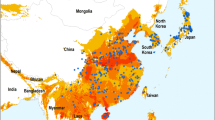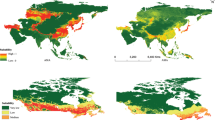Abstract
Biological invasions have long placed challenges on ecosystems, agricultural production, and human health. Modeling potential invasion of an introduced organism becomes a critical tool for early management of damaging species, such as kudzu bug, Megacopta cribraria (F.) (Hemiptera:Heteroptera:Plataspidae). Since it was first found in the United States in 2009, kudzu bug has spread rapidly, economically impacted agricultural production, and became a household pest. To better predict the potential invasion of kudzu bug in North and South America, we used the species distribution models Genetic Algorithm for Rule-set Production (GARP) and Maximum Entropy (Maxent). We used the D metric to test for niche equivalency and similarity between native and invaded populations of kudzu bug. We found that kudzu bugs currently occupied unequal environmental space between the two ranges. Therefore, distribution models using GARP and Maxent were constructed using occurrences in both native and invaded ranges. Area under the curve (AUC), true skill statistics (TSS), and omission rate (OR) were used to evaluate and compare the models. Results indicated both models had good performance, but Maxent (AUC = 0.971, TSS = 0.946, OR = 0.019) performed better than GARP (AUC = 0.922, TSS = 0.860, OR = 0.037). This research confirmed the effectiveness of using occurrence data in both ranges to predict potential invasions. Kudzu bugs prefer warm (annual mean temperature around 15 °C) and humid (annual mean precipitation around 1300 mm) regions. Distribution models generated by both methods indicated similar regions with high invasion risk. Management programs that include quarantine and prevention measures are suggested for these regions to avoid outbreaks of kudzu bug.





Similar content being viewed by others
References
Allouche O, Tsoar A, Kadmon R (2006) Assessing the accuracy of species distribution models: prevalence, kappa and the true skill statistic (TSS). J Appl Ecol 43:1223–1232
Beardsley JW, Fluker S (1967) Coptosoma xanthogramma (White), (Hemiptera: Plataspidae) a new pest of legumes in Hawaii. Proc Haw Entomol Soc 19:367–372
Broennimann O, Guisan A (2008) Predicting current and future biological invasions: both native and invaded ranges matter. Biol Lett 4:585–589
Broennimann O, Treier UA, Müller-Schärer H, Thuiller W, Peterson AT, Guisan A (2007) Evidence of climatic niche shift during biological invasion. Ecol Lett 10:701–709
Broennimann O, Fitzpatrick MC, Pearman PB, Petitpierre B, Pellissier L, Yoccoz NG, Thuiller W, Fortin MJ, Randin C, Zimmermann NE, Graham CH (2012) Measuring ecological niche overlap from occurrence and spatial environmental data. Glob Ecol Biogeogr 21:481–497
Costa GC, Nogueira C, Machado RB, Colli GR (2010) Sampling bias and the use of ecological niche modeling in conservation planning: a field evaluation in a biodiversity hotspot. Biodivers Conserv 19:883–899
Di Cola V, Broennimann O, Petitpierre B, Breiner FT, D’amen M, Randin C, Engler R, Pottier J, Pio D, Dubuis A, Pellissier L (2017) Ecospat: an R package to support spatial analyses and modeling of species niches and distributions. Ecography 40:774–787
EDDMapS (2017) Early detection and distribution mapping system. In: University of Georgia center for invasive species ecosystem heal. www.eddmaps.org. Accessed 25 Jan 2017
Eger JE Jr, Ames LM, Suiter DR, Jenkins TM, Rider DA, Halbert SE (2010) Occurrence of the old world bug Megacopta cribraria (Fabricius) (Heteroptera: Plataspidae) in Georgia: a serious home invader and potential legume pest. Insecta Mundi 2010:1–11
Fabricius JC (1798). Entomologia systematica emendata et auct, secundum classes, ordines, genera, species, adjectis synonymis, locis, observationibus. Supplementum. Proft et Storch, Gopenhagan. ii: 572
Fielding AH, Bell JF (1997) A review of methods for the assessment of prediction errors in conservation presence/absence models. Environ Conserv 24:38–49
Gallien L, Münkemüller T, Albert CH, Boulangeat I, Thuiller W (2010) Predicting potential distributions of invasive species: where to go from here? Divers Distrib 16:331–342
Gardner WA, Olson DM (2016) Population Census of Megacopta cribraria (Hemiptera: Plataspidae) in Kudzu in Georgia, USA, 2013–2016. J Entomol Sci 51:325–328
Gardner WA, Peeler HB, LaForest J et al (2013) Confirmed distribution and occurrence of Megacopta cribraria (F.) (Hemiptera: Heteroptera: Plataspidae) in the southeastern United States. J Entomol Sci 48:118–127
Guisan A, Zimmermann NE (2000) Predictive habitat distribution models in ecology. Ecol Model 135:147–186
Guisan A, Petitpierre B, Broennimann O (2014) Unifying niche shift studies: insights from biological invasions. Trends Ecol Evolut 29:260–269
Hernandez PA, Graham CH, Master LL, Albert DL (2006) The effect of sample size and species characteristics on performance of different species distribution modeling methods. Ecography 29:773–785
Hijmans RJ, Cameron SE, Parra JL, Jones PG, Jarvis A (2005) Very high resolution interpolated climate surfaces for global land areas. Int J Climatol 25:1965–1978
Hutchinson GE (1957) Concluidng remarks. Cold Spirng Harb Symp Quant Biol 22:415–442
Jiménez-Valverde A, Lobo JM (2007) Threshold criteria for conversion of probability of species presence to either–or presence–absence. Acta Oecol Int J Ecol 31:361–369
Jiménez-Valverde A, Peterson AT, Soberón J, Overton JM, Aragón P, Lobo JM (2011) Use of niche models in invasive species risk assessments. Biol Invasions 13:2785–2797
Kay T (2005) Labor transnationalism and global governance: the impact of NAFTA on transnational labor relationships in North America 1. Am J Socio 111:715–756
Li YH, Pan ZS, Zhang JP, Li WS (2001) Observation of biology and behavior of Megacopta cribraria (Fabricius). Plant Prot Technol Ext 21:11–12
Liebhold AM, MacDonald WL, Bergdahl D, Mastro VC (1995) Invasion by exotic forest pests: a threat to forest ecosystems. For Sci Monogr 30:1–49
Liu C, Berry PM, Dawson TP, Pearson RG (2005) Selecting thresholds of occurrence in the prediction of species distributions. Ecography 28:385–393
Mack RN, Simberloff D, Lonsdale WM, Evans H, Clout M, Bazzaz F (2000) Biotic invasions: causes, epidemiology, global consequences, and control. Ecol Appl 10:689–710
Muñoz MES, De Giovanni R, de Siqueira MF, Sutton T, Brewer P, Pereira RS, Canhos DAL, Canhos VP (2011) OpenModeller: a generic approach to species’ potential distribution modelling. Geoinformatica 15:111–135
Peterson AT (2003) Predicting the geography of speices’ invasions via ecological niche modeling. Q Rev Biol 78:419–433
Peterson AT, Papeş M, Eaton M (2007) Transferability and model evaluation in ecological niche modeling: a comparison of GARP and Maxent. Ecography 30:550–560
Petitpierre B, Kueffer C, Broennimann O, Randin C, Daehler C, Guisan A (2012) Climatic niche shifts are rare among terrestrial plant invaders. Science 335:1344–1348
Phillips SJ, Dudík M (2008) Modeling of species distributions with Maxent: new extensions and a comprehensive evaluation. Ecography 31:161–175
Phillips SJ, Anderson RP, Schapire RE (2006) Maximum entropy modeling of species geographic distributions. Ecol Model 190:231–259
Pimentel D, Zuniga R, Morrison D (2005) Update on the environmental and economic costs associated with alien-invasive species in the United States. Ecol Econ 52:273–288
Randin CF, Dirnböck T, Dullinger S, Zimmermann NE, Zappa M, Guisan A (2006) Are niche-based species distribution models transferable in space? J Biogeog 33:1689–1703
Ruberson JR, Takasu K, Buntin GD et al (2013) From Asian curiosity to eruptive American pest: Megacopta cribraria (Hemiptera: Plataspidae) and prospects for its biological control. App Entomol Zool 48:3–13
Schoener TW (1968) The Anolis lizards of Bimini: resource partitioning in a complex fauna. Ecology 49:704–726
Seiter NJ, Greene JK, Reay-Jones FP (2012) Reduction of soybean yield components by Megacopta cribraria (Hemiptera: Plataspidae). J Econ Entomol 106:1676–1683
Shi S, Cui J, Zang L (2014) Development, survival, and reproduction of Megacopta cribraria (Heteroptera: Plataspidae) at different constant temperatures. J Econ Entomol 107:2061–2066
Sing T, Sander O, Beerenwinkel N, Lengauer T (2005) ROCR: visualizing classifier performance in R. Bioinformatics 21:3940–3941
Sobek-Swant S, Kluza DA, Cuddington K, Lyons DB (2012) Potential distribution of emerald ash borer: what can we learn from ecological niche models using Maxent and GARP? For Ecol Manag 281:23–31
Soberón J, Peterson AT (2005) Interpretation of models of fundamental ecological niches and speices’ distributional areas. Biodivers Inform 2:1–10
Soberón J, Peterson AT (2011) Ecological niche shifts and environmental space anisotropy: a cautionary note. Rev Mex Biodivers 82:1348–1355
Stockwell D, Peters D (1999) The GARP modelling system: problems and solutions to automated spatial prediction. Int J Geogr Inform Sci 13:143–158
Strubbe D, Broennimann O, Chiron F, Matthysen E (2013) Niche conservatism in non-native birds in Europe: niche unfilling rather than niche expansion. Glob Ecol Biogeogr 22:962–970
Suiter D, Eger J, Gardner W et al (2010) Discovery and distribution of Megacopta cribraria (Hemiptera: Heteroptera: Plataspidae) in northeast Georgia. J Integr Pest Manag 1:F1–F4
Sutherst RW (2003) Prediction of species geographical ranges. J Biogeog 30:805–816
Swets JA (1988) Measuring the accuracy of diagnostic systems. Sciences 240:1285–1293
Tsoar A, Allouche O, Steinitz O, Rotem D, Kadmon R (2007) A comparative evaluation of presence only methods for modelling species distribution. Divers Distrib 13:397–405
USGS (1996) HYDRO1k elevation derivative database. http://lta.cr.usgs.gov/hydro1k. Accessed on 22 Aug 2016
Václavík T, Meentemeyer RK (2009) Invasive species distribution modeling (iSDM): Are absence data and dispersal constraints needed to predict actual distributions? Ecol Model 220:3248–3258
Vitousek PM, D’antonio CM, Loope LL, Rejmánek M, Westbrooks R (1997) Introduced species: a significant component of human-caused global change. New Zeal J Ecol 21:1–16
Wang Z, Wang H, Chen G, Zhuge Z, Tong C (1996) Occurrence and control of Megacopta cribraria (Fabricius) on soybean. Plant Prot 3:7–9
Warren DL, Glor RE, Turelli M (2008) Environmental niche equivalency versus conservatism: quantitative approaches to niche evolution. Evolution 62:2868–2883
Wiens JJ, Graham CH (2005) Niche conservatism: integrating evolution, ecology, and conservation biology. Ann Rev Ecol Evol Syst 36:519–539
Wu M, Wu Z, Hua S (2006) A preliminary study on some biological characters of globular stink bug, Megacopta cribraria and its two egg parasitoids. J Fujian Agric For Univ (Nat Sci Edn) 35:147–150
Zhang Y, Hanula JL, Horn S (2012) The biology and preliminary host range of Megacopta cribraria (Heteroptera: Plataspidae) and its impact on kudzu growth. Environ Entomol 41:40–50
Zhu G, Petersen MJ, Bu W (2012) Selecting biological meaningful environmental dimensions of low discrepancy among ranges to predict potential distribution of bean plataspid invasion. PLoS ONE 7:e46247
Acknowledgements
The authors thank the China Scholarship Council for their financial support of W. Liang’s academic program. We would like to extend our appreciation towards Dr. Gengping Zhu of Tianjin Normal University, China, for providing us with his kudzu bug geographic presence data for Asia. For critical suggestions and discussion, we thank Dr. Monica Papeş of the University of Tennessee, Knoxville. We also thank the Newton High Performance Computer (HPC) Program at the University of Tennessee, Knoxville, for providing use of their system. Last but not least, we are grateful to the anonymous reviewers for their valuable comments on earlier draft of this paper.
Author information
Authors and Affiliations
Corresponding author
Rights and permissions
About this article
Cite this article
Liang, W., Tran, L., Washington-Allen, R. et al. Predicting the potential invasion of kudzu bug, Megacopta cribraria (Heteroptera: Plataspidae), in North and South America and determining its climatic preference. Biol Invasions 20, 2899–2913 (2018). https://doi.org/10.1007/s10530-018-1743-y
Received:
Accepted:
Published:
Issue Date:
DOI: https://doi.org/10.1007/s10530-018-1743-y




